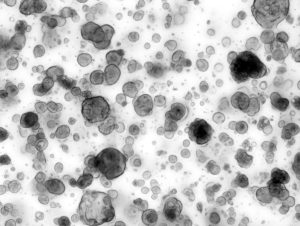
March 6, 2024
Salk scientists test whether different commercial cell culture products affect organoid development and response to pancreatic cancer drugs
Salk scientists test whether different commercial cell culture products affect organoid development and response to pancreatic cancer drugs
LA JOLLA—Pancreatic cancer has the highest mortality rate of all major cancers and is projected to become the second-leading cause of cancer-related deaths in the United States by 2030. It is especially difficult to treat because pancreatic tumors grow so quickly and are constantly evolving, making them prone to developing drug resistance.
Patient-derived organoids could change all that. In this emerging biotechnology, researchers obtain small tissue samples from patient biopsies and use them to grow three-dimensional cell cultures in the lab. These organoids act as miniature models of the patient’s pancreatic tumor, and can be used to test various drugs and evaluate which cancer treatments might work best.

The excitement over this tool’s clinical potential has led to an explosion of innovation in recent years. More than a dozen clinical trials of patient-derived organoids are currently in progress. However, the rush to get them into clinical trials has meant many experimental variables have yet to be fully vetted.
A recent study at the Salk Institute provides critical insights into the reliability and robustness of patient-derived organoids as a clinical model of pancreatic cancer. The findings, published January 9, 2024, in JCI Insight, reveal that organoids’ gene expression and drug responses are not affected by the brand of extracellular matrix used in the cell culture. However, one commercial product did increase the growth rate of pancreatic tumor organoids, making it particularly well-suited for the fast pace of pancreatic cancer treatment protocols.
“Everyone’s tumor is different, so we need personalized medicine to match a specific treatment to a specific tumor,” says senior author Dannielle Engle, an assistant professor and the Helen McLoraine Developmental Chair at Salk. “Instead of having to play this guessing game, patient-derived organoids offer clinicians a predictive model that helps them choose the right treatment from the beginning.”

As organoid biotechnology advances, the availability of commercial products to support this research has increased. Most organoids are grown in culture media, a liquid that supplies the cells with various nutrients they need to survive. In order to grow, the cells also need something to adhere to. In the human body, they're surrounded by an extracellular matrix made of proteins and other molecules that provide a scaffold for the cells to grow on. In the lab, scientists obtain this matrix material from a variety of commercial sources. Depending on the duration of the trial or the status of the commercial supply chain, labs may have to use matrices from multiple commercial batches or even multiple brands to complete their experiments.
Several studies have recently shown that the type of liquid culture media that organoids are grown in can affect their phenotype, transcriptome, and drug response, meaning different cancer treatments might be recommended depending on which kind of culture media the organoid was grown in. Engle and her team set out to evaluate whether differences in extracellular matrices could have a similar effect.
“Whenever you’re developing a new clinical assay, you need to know how robust that assay is,” says Engle. “It needs to give you the same result whether you’re doing the test in a lab in California, Canada, or New York.”
First author Jan C. Lumibao, a postdoctoral researcher in Engle’s lab at the time of the study, tested the three most common brands of extracellular matrix: Matrigel, Cultrex, and UltiMatrix. Using a variety of research methods, he evaluated whether these different products had an effect on the organoids’ growth rate, gene expression, and drug response.
The findings showed that using different commercial matrices did not produce significant changes in the organoids’ gene expression patterns or drug responses, but did have some effect on the tissues’ growth rate.
“These matrices are biologically active, meaning there are real proteins and signaling molecules in them that could be interacting with the organoid, so the fact that we didn’t see significant differences in gene expression or drug response with the different brands of matrix was pleasantly surprising, and a big relief,” says Lumibao.
The researchers tested six different pancreatic cancer drugs—Gemcitabine, Abraxane, Oxaliplatin, Irinotecan, Fluorouracil, and Trametinib—and confirmed that using any one of the three commercial matrices would not have changed the clinical call for any patient.
However, one feature of the organoids was influenced by the brand of matrix. Pancreatic tumor organoids grew much faster in Matrigel compared to the other two types—which is a good thing. The faster the organoid grows, the sooner clinicians get the experimental results, and the earlier the patient can start treatment.
“In pancreatic cancer, timing is everything,” says Engle. “By the time you figure out that a drug isn’t working in the patient, it’s often too late to change their treatment plan. We want to sort this out as soon as possible, before the treatment has even begun.”
Engle says Cultrex and UltiMatrix are fine to use for organoid models and are unlikely to change experimental results, but the experiments will likely take 20-40% longer.
So why did different culture medias have such an effect on organoids, but different kinds of extracellular matrix did not? The researchers note that each lab’s culture media can include its own recipe of growth factors, whereas extracellular matrices tend to have the same array of growth factors, but at varying concentrations. These variations may be subtle enough to not have a dramatic effect on the organoids.
“Our findings provide further confidence that patient-derived organoids are an accurate and robust platform for evaluating patient drug response and informing clinical decisions,” says Engle. “Our teams at Salk are continuing to optimize organoid technology and confirm its utility in clinical settings, and we’re excited to see this impact patient outcomes in the future.”
Other authors include Shira R. Okhovat, Kristina L. Peck, Xiaoxue Lin, Kathryn Lande, and Shira Yomtoubian of Salk, and Isabella Ng, Hervé Tiriac, Andrew M. Lowy, and Jingjing Zou of UC San Diego.
The work was supported by the National Institutes of Health (R00CA024725, P30DK120515, T32CA009370, NIH-NCI CCSG: P30014195, NIH-NCI CCSG: P30014195, NIH-NCI CCSG: P30CA23100), the Pancreatic Cancer Action Network (19-20-ENGL), American Association for Cancer Research, the Lustgarten Foundation (21-20-67-ENGL), the University of California Tobacco-Related Disease Research Program (T31KT1898), Padres Pedal the Cause/C3 (#PTC2020), the Rose Hills Foundation, Mission Cure Capital LLC, the Mark Foundation for Cancer Research, the Emerald Foundation Inc., the Chapman Foundation, and the Helmsley Charitable Trust.
DOI: 10.1172/jci.insight.172419
JOURNAL
JCI Insight
AUTHORS
Jan C. Lumibao, Shira R. Okhovat, Kristina L. Peck, Xiaoxue Lin, Kathryn Lande, Shira Yomtoubian, Isabella Ng, Hervé Tiriac, Andrew M. Lowy, Jingjing Zou, Dannielle D. Engle.
Office of Communications
Tel: (858) 453-4100
press@salk.edu
Unlocking the secrets of life itself is the driving force behind the Salk Institute. Our team of world-class, award-winning scientists pushes the boundaries of knowledge in areas such as neuroscience, cancer research, aging, immunobiology, plant biology, computational biology and more. Founded by Jonas Salk, developer of the first safe and effective polio vaccine, the Institute is an independent, nonprofit research organization and architectural landmark: small by choice, intimate by nature, and fearless in the face of any challenge.